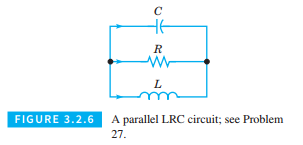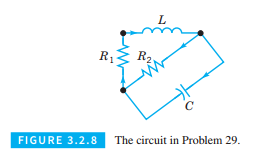
Concept explainers
Applications.
Electric Circuits. The theory of electric circuits, such as that shown in Figure 3.2.6, consisting of inductors, resistors, and capacitors, is based on Kirchhoff’s laws: (1) At any node (or junction), the sum of currents flowing into that node is equal to the sum of currents flowing into that node is equal to the sum of currents flowing out of that node, and (2) the net voltage drop around each closed loop is zero. In addition to Kirchhoff’s laws, we also have the relation between the current
Kirchhoff’s laws and the current-voltage relation for each circuit element provide a system of algebraic and differential equations from which the voltage and current throughout the circuit can be determined. Problems 27 through 29 illustrate the procedure just described.

Consider the circuit shown in the Figure 3.2.8. Use the method outlined in problem 27 to show that the current

Want to see the full answer?
Check out a sample textbook solution
Chapter 3 Solutions
Differential Equations: An Introduction to Modern Methods and Applications
Additional Math Textbook Solutions
Calculus: Early Transcendentals (2nd Edition)
A First Course in Probability (10th Edition)
Elementary Statistics: Picturing the World (7th Edition)
Basic Business Statistics, Student Value Edition
Elementary and Intermediate Algebra: Concepts and Applications (7th Edition)
Elementary Statistics (13th Edition)
- not use ai pleasearrow_forward1. Abel's Theorem. The goal in this problem is to prove Abel's theorem by following a series of steps (each step must be justified). Theorem 0.1 (Abel's Theorem). If y1 and y2 are solutions of the differential equation y" + p(t) y′ + q(t) y = 0, where p and q are continuous on an open interval, then the Wronskian is given by W (¥1, v2)(t) = c exp(− [p(t) dt), where C is a constant that does not depend on t. Moreover, either W (y1, y2)(t) = 0 for every t in I or W (y1, y2)(t) = 0 for every t in I. 1. (a) From the two equations (which follow from the hypotheses), show that y" + p(t) y₁ + q(t) y₁ = 0 and y½ + p(t) y2 + q(t) y2 = 0, 2. (b) Observe that Hence, conclude that (YY2 - Y1 y2) + P(t) (y₁ Y2 - Y1 Y2) = 0. W'(y1, y2)(t) = yY2 - Y1 y2- W' + p(t) W = 0. 3. (c) Use the result from the previous step to complete the proof of the theorem.arrow_forwardeBook Print Item Question Content Area Support Department Cost Allocation—Reciprocal Services Method Blue Africa Inc. produces laptops and desktop computers. The company’s production activities mainly occur in what the company calls its Laser and Forming departments. The Cafeteria and Security departments support the company’s production activities and allocate costs based on the number of employees and square feet, respectively. The total cost of the Security Department is $261,000. The total cost of the Cafeteria Department is $300,000. The number of employees and the square footage in each department are as follows: Department Employees Square Feet Security 10 570 Cafeteria 28 2,400 Laser 40 4,800 Forming 50 800 Using the reciprocal services method of support department cost allocation, determine the total costs from the Security Department that should be allocated to…arrow_forward
- I need help with this problem and an explanation of the solution for the image described below. (Statistics: Engineering Probabilities)arrow_forwardI need help with this problem and an explanation of the solution for the image described below. (Statistics: Engineering Probabilities)arrow_forward2. Observations on the Wronskian. Suppose the functions y₁ and y2 are solutions to the differential equation p(x)y" + q(x)y' + r(x) y = 0 on an open interval I. 1. (a) Prove that if y₁ and y2 both vanish at the same point in I, then y₁ and y2 cannot form a fundamental set of solutions. 2. (b) Prove that if y₁ and y2 both attain a maximum or minimum at the same point in I, then y₁ and Y2 cannot form a fundamental set of solutions. 3. (c) show that the functions & and t² are linearly independent on the interval (−1, 1). Verify that both are solutions to the differential equation t² y″ – 2ty' + 2y = 0. Then justify why this does not contradict Abel's theorem. 4. (d) What can you conclude about the possibility that t and t² are solutions to the differential equation y" + q(x) y′ + r(x)y = 0?arrow_forward
- This exercise is based on the following data on four bodybuilding supplements. (Figures shown correspond to a single serving.) Creatine(grams) L-Glutamine(grams) BCAAs(grams) Cost($) Xtend(SciVation) 0 2.5 7 1.00 Gainz(MP Hardcore) 2 3 6 1.10 Strongevity(Bill Phillips) 2.5 1 0 1.20 Muscle Physique(EAS) 2 2 0 1.00 Your personal trainer suggests that you supplement with at least 10 grams of creatine, 39 grams of L-glutamine, and 90 grams of BCAAs each week. You are thinking of combining Xtend and Gainz to provide you with the required nutrients. How many servings of each should you combine to obtain a week's supply that meets your trainer's specifications at the least cost? (If an answer does not exist, enter DNE.) servings of xtend servings of gainzarrow_forwardPROBLEM 7: Binary Relations, Functions and Orderings (15 pts) 1. (2 pts) Prove that ({2, 3, 4, 6, 24, 36, 72}, /) is a poset, create its corresponding Hasse diagram and identify maximal and minimal elements. 2. (1 pts) Prove that (P{1, 2, 3}, C) is a poset, create its corresponding Hasse diagram and identify maximal and minimal elements 3. Assume the following mapping, captured by variable map: map = { 72 {1,2,3}, 36 {3}, 24 {1,2}, 6- → {3}, 4 {1,3}, 2➡ {} } Provide answers to the following in detail (in plain english and formally): (a) (2 pts) Is variable map a function? If so, is it a total or a partial function? Identify domain and codomain. (b) (10 pts) Discuss all properties (injectivity, surjectivity, bijection, order preserving, order reflecting, order embedding, isomorphism). NOTE: When we reason formally on a property we must state: (1) What Law do we expect to hold or not hold, and (2) Does this Law indeed hold or Is this Law violated?arrow_forwardI need help with this problem and an explanation of the solution for the image described below. (Statistics: Engineering Probabilities)arrow_forward
- I need help with this problem and an explanation of the solution for the image described below. (Statistics: Engineering Probabilities)arrow_forwardDATA TABLE VALUES Meal Price ($) 22.78 31.90 33.89 22.77 18.04 23.29 35.28 42.38 36.88 38.55 41.68 25.73 34.19 31.75 25.24 26.32 19.57 36.57 32.97 36.83 30.17 37.29 25.37 24.71 28.79 32.83 43.00 35.23 34.76 33.06 27.73 31.89 38.47 39.42 40.72 43.92 36.51 45.25 33.51 29.17 30.54 26.74 37.93arrow_forwardI need help with this problem and an explanation of the solution for the image described below. (Statistics: Engineering Probabilities)arrow_forward
- Algebra & Trigonometry with Analytic GeometryAlgebraISBN:9781133382119Author:SwokowskiPublisher:Cengage
 Elementary Linear Algebra (MindTap Course List)AlgebraISBN:9781305658004Author:Ron LarsonPublisher:Cengage Learning
Elementary Linear Algebra (MindTap Course List)AlgebraISBN:9781305658004Author:Ron LarsonPublisher:Cengage Learning Linear Algebra: A Modern IntroductionAlgebraISBN:9781285463247Author:David PoolePublisher:Cengage Learning
Linear Algebra: A Modern IntroductionAlgebraISBN:9781285463247Author:David PoolePublisher:Cengage Learning  Algebra: Structure And Method, Book 1AlgebraISBN:9780395977224Author:Richard G. Brown, Mary P. Dolciani, Robert H. Sorgenfrey, William L. ColePublisher:McDougal Littell
Algebra: Structure And Method, Book 1AlgebraISBN:9780395977224Author:Richard G. Brown, Mary P. Dolciani, Robert H. Sorgenfrey, William L. ColePublisher:McDougal Littell



